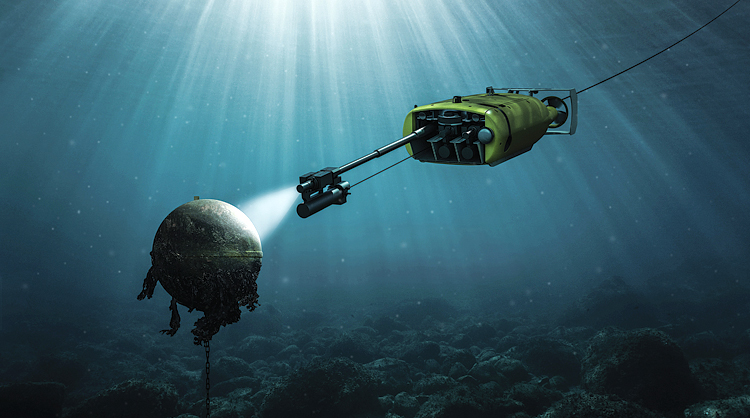- Prime Minister Narendra Modi inaugurates Aero India 2023 in Bengaluru; Releases Commemorative Stamp
- Defence Secretary meets delegations from Saudi Arabia, USA and Oman on the sidelines of Aero India 2023
- Foreign Ministers of 32 countries to attend Aero India 2023
- Embraer showcases the C-390 Millennium at Aero India 2023
Combatting Sea Threats with Unmanned Solutions
Saab’s Double EagleMkIV can be an effective addition to India’s Mine Counter Measure (MCM) capabilities, says Ola Rignell, Managing Director, Saab India

More than 90 per cent of the world’s trade happens by sea, so any disruptions to the global flow can have serious consequences. The Indian Ocean Region is an important Sea Lines of Communication as it is both energy and trade corridor. Sea mines are an inexpensive but low-tech weapon that can cause havoc with trade and communication. Since the end of the Second World War, more ships have been lost to one maritime weapon than any other. But it’s not anti-ship missiles, torpedoes, or terrorist attacks; it is sea mines. Not having minesweeping capabilities can have deadly consequences as even modified fishing trawlers can be used for laying mines. Illegal, Unregulated and Unreported (IUU) fishing is one of the gravest nontraditional global maritime security threats which can now also be used to lay mines.
Modern mine reconnaissance and mine disposal demand a multifunctional Remotely Operated Vehicle (ROV) that can operate in extreme environments and cope with advanced mines. Saab’s new MuMNS (Multi-Shot Mine Neutralisation System) could be a breakthrough in countering mine warfare.
According to Ola Rignell, Managing Director, Saab India, “With Indian Navy looking to enhance their Mine Counter Measure (MCM) capabilities by acquiring mine countermeasures vessels (MCMVs) that can be built in India, Saab’s Double EagleMkIV can be an effective addition to India’s MCM suite. Not only is it designed to handle modern sea mines, the modularity of the design allows the operator to utilise the vehicles for both mine detection and mine disposal. The stability of the vehicle simplifies these missions. MuMNS including the Double Eagle MkIV has also been adapted to the Craft Of Opportunities (COOP), where it can be housed in a container that can be easily installed on almost any type of ship.”
Sea mines are unremarkable-looking, iron-encased explosives, most often placed under the water’s surface (buoyant mines) or on the seabed (ground mines). There they float or sit silently for years, until a ship or submarine strikes them directly, or produces the right magnetic, acoustic or pressure signal to set them off. The resulting explosion can be every bit as devastating as, say, a missile. In just a four-day period during the first Gulf War in 1991, the US Navy saw the USS Princeton and USS Tripoli put out of action for several months due to the damage caused by Iraqi sea mines.

“A sea mine gives you area denial. They are an inexpensive and highly effective way of waging a maritime campaign,” explains Chris Lade, Engineering and Defence Sales Manager at Saab Seaeye. Before joining Saab, Lade spent 31 years with the British Royal Navy, as a navy diver who actually laid charges to neutralise sea mines, and as a planner during the 2nd Gulf War to clear Iraqi waters for Allied vessels.
“They are used in key waterways, such as the Straits of Hormuz in the Middle East, the Malacca Strait in Indonesia, the Bosporus in Turkey or the Kattegat entrance to the Baltic Sea. If these ‘chokepoints’ are closed off due to mines, they make a big strategic impact at a relatively low cost. Sometimes forces make it look like they have laid mines. The threat alone is enough to disrupt sea lines of communication, affecting trade, logistics and naval patrols,” says Lade, though it contravenes the Hague Convention on mine usage.
Saab’s solution to these problems represents a breakthrough for safer seas. It has been six years in the making, involving a core team of 12 people, including Lade. “The MuMNS can go down and use a camera to identify a target. The beauty of MuMNS is that you have three weapons rather than one, and you have an ROV that has ‘six degrees of freedom’: it can fly upside down, manoeuvre through 360 degrees, and look at a whole range of targets over a large area. It can be left in the water rather than needing to be retrieved by the ship to be rearmed,” says Lade. Add to that its ability to operate from an Unmanned Surface Vessel, a 12-metrelong platform that is remote controlled.
Once the MuMNS charge is attached, a radio receiver floats up to the surface, the charge is then fired remotely from the mother ship on the horizon or beyond. It is essentially taking the man out of the minefield. MuMNS will change the nature of mine warfare around the world and keep a lot of ships and people safe.





